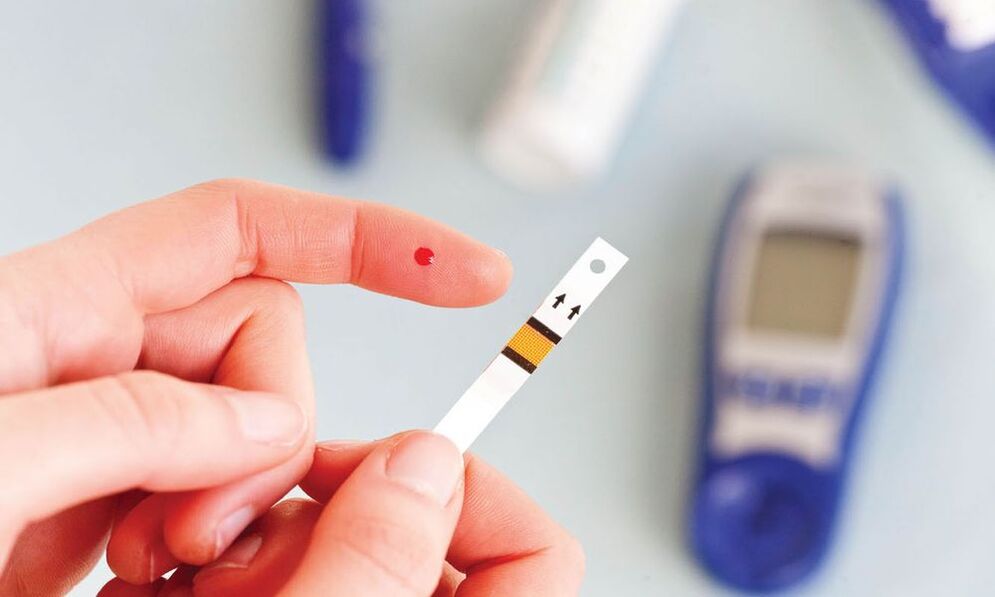
You can identify diabetes by paying attention to the symptoms that appear. With this endocrine disease, the state of health is getting worse and worse. At first, many patients do not even notice the first symptoms of diabetes, although with type I pathology they reduce the quality of life of a person for several days. The later the disease is detected, the more difficult it is to recover. Keeping in mind the signs of diabetes, this will allow you to consult your doctor promptly if they occur.
Features of the disease
Diabetes mellitus is a serious endocrine disease in which there is an absolute or relative deficiency of insulin. In the first case, it is not produced by the pancreatic cells in the required amount, and in the second case, it disrupts the interaction of this hormone with the target cells.
Insulin is needed so that glucose entering the body can be absorbed by tissues. If the hormone fails to perform its functions, then sugar stays in the bloodstream for a long time. As a result, tissues and organs do not receive the energy they need.

The pathology is manifested by the development of persistent hyperglycemia. Concentrations of sugar are consistently higher than standard. In this disease, all kinds of metabolism are disturbed. Problems arise from the metabolism of carbohydrates, fats, salts, water, proteins and minerals.
Classify
Endocrinologists distinguish the following types of diabetes:
- insulin dependent (type I);
- non-insulin dependent (type II);
- Pregnancy.
Type I diabetes is insulin dependent. This form of the disease is found mainly in children and young people. The main symptoms in type I pathology are pronounced. In this form of the disease, insulin is not produced in the body of the patient, so the patient needs to inject this hormone daily.
In type II, the first signs do not appear immediately, they are mild. A person may not suspect that he or she has a health problem for several years from the onset of the illness. Insulin is produced in the body, but the target cells become insensitive to it.
Gestational diabetes occurs during pregnancy. After childbirth, the condition returns to normal, but a woman needs to be careful and follow a diet. Patients with this form are at risk for type 2 disease.
First sign of diabetes
All symptoms of this endocrine pathology are divided into major and minor. Their appearance is characteristic of both forms of the disease. But people who are insulin dependent mostly develop primary symptoms. They become evident during the time that no more than 20% of the cells responsible for insulin production remain in the pancreas.
Key features include:
- polyuria - increased urination, increased urine volume;
- polydipsia - the appearance of an obsessive thirst that cannot be quenched, the patient can drink more than 5 liters of water per day;
- polyphagia - increased hunger, after a meal there is no feeling of fullness;
- weight loss - with the development of insulin dependence, people quickly lose weight.
In the first form of the disease, patients can even approximate the date on which they first felt unwell.
But the main symptoms also occur in type II of the disease. Their severity gradually increases. As a result, patients are often unable to say when they first felt changes in their health. Non-insulin dependent patients notice the onset of minor symptoms earlier. But many of them can be confused with other diseases, so people don't immediately turn to an endocrinologist.

Secondary symptoms include the following:
- dryness in the mouth;
- itching of the skin and mucous membranes;
- muscle weakness, increased fatigue;
- difficult-to-treat skin lesions;
- visual disturbances;
- persistent headache;
- metallic taste in the mouth;
- limb numbness.
But primary and secondary signs develop in all forms of pathology. It is possible to understand what type a patient has without conducting a comprehensive examination on a specific basis. But for the specification of the diagnosis, the selection of the therapeutic diagnosis is mandatory.
Symptoms of type 1
People whose cells responsible for insulin production are destroyed will feel constantly hungry. With an increase in food intake, their weight may decrease. Noticing such changes, it is necessary to immediately donate blood for sugar.
Other symptoms of insulin dependence include:
- increased nerve excitability;
- vomiting, nausea for no reason;
- the smell of acetone when breathing;
- painful heart area;
- sleep disorders;
- headache.
The presence of even one symptom should not be ignored. You can understand that there are problems by going through an analysis to determine the blood sugar level. If you do not start insulin therapy when the first signs appear, the patient's condition will rapidly deteriorate, he may fall into a diabetic coma.
Type 2 symptoms
Specific changes that may be suspected for the development of the non-insulin dependent form of the disease include:
- aching limbs;
- cramps in the muscles of the legs and arms;
- weight gain;
- decreased libido, problems with potency;
- reduced sensitivity to pain;
- weakening of the immune system;
- the appearance on the body of xanthomas - yellow formation occurs in violation of fat metabolism;
- increased facial hair growth while reducing the amount of hair on the legs.
But these symptoms in patients are usually mild, so people do not pay attention. Many problems are discovered by accident during a routine inspection.
Features of appearance
There were no significant differences in the development of the disease in men and women. It starts the same way in both sexes. They may differ only in minor symptoms.
The severity of pathological signs and the rate of development of the disease directly depend on the age of the person. Children and adolescents diagnosed with type I diabetes. People over the age of 40 develop type II diabetes.

Non-insulin-dependent diseases are commonly found in patients with:
- have an inactive lifestyle;
- being overweight;
- consume simple carbohydrates in large quantities;
- experiencing ongoing psycho-emotional stress.
You can distinguish diseases by symptoms.
Still young
Young people develop a predominantly insulin-dependent form of diabetes. This diagnosis is made for patients under 30 years of age. A doctor should be consulted if a child or young adult urinates frequently, and the amount of fluid intake increases significantly.
The chance of developing the disease is higher in children who:
- have a genetic predisposition to developing diabetes;
- born with a weight of 4. 5 kg;
- have metabolic disorders (obesity, hypothyroidism);
- infected with a virus, so the cells of the pancreas (rubella, measles, mumps and others) can be damaged.
With the mild form in children and adolescents, symptoms are not always present, they are barely visible. Symptoms will only appear as the disease progresses.
In men
In adult patients, there is an increased risk of developing type 2 pathology. Men are prone to diabetes. With excessive weight gain, the abdominal volume increases primarily. With visceral obesity, the pressure on the internal organs increases, the work of the pancreas is disrupted.
The alarming symptoms are impaired libido and impotence. A characteristic symptom may be balanitis - it occurs due to increased urination. The development of this condition contributes to the active reproduction of pathogenic bacteria.
Among the women
One of the symptoms of diabetes is itchy mucous membranes. More often, women have to deal with its appearance - they have discomfort in the genital area. Most of them go to gynecologists with suspicions of contracting sexually transmitted diseases. If, according to the test results, there are no STDs, there are no problems with the microbiome, then the doctor may recommend testing the sugar level.
Diagnose
If you have symptoms of an endocrine disorder, you should see a doctor. Diabetes can be detected by tests that identify:
- fasting blood glucose concentration;
- glycated hemoglobin - shows the average sugar level the patient has over the past 2-3 months;
- Glucose tolerance test - an analysis done on an empty stomach and repeated after glucose ingestion.
Your doctor may suggest a blood donation at any time, without prior preparation. This is necessary if there are signs that are characteristic of diabetes.
Which doctor to contact?
Patients who develop major, minor, or diabetes-specific signs should make an appointment with an endocrinologist. But a therapist can make a preliminary diagnosis - he will give directions for the necessary tests.
Based on the results of the examination, the endocrinologist can immediately make recommendations about nutrition, lifestyle changes and drug treatment. For diseases of the first type, insulin injections are indispensable. Patients with type II diabetes are prescribed dietary therapy, selecting drugs, under the influence of which target cells begin to more actively absorb insulin and glucose.



























